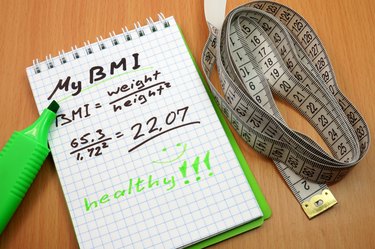
Instead of aiming for an ideal weight, which doesn't necessarily exist, you may want to work toward a weight within the healthy range for your height. If you know how much lean mass you have, and thus how much body fat, you can use an equation to determine how much weight you need to lose to lower your body fat percentage to get it into a healthier range. A doctor or dietitian can advise you on how much you should weigh to minimize your disease risk.
Measuring Body Fat
Video of the Day
To determine how much lean body mass you have, you need to figure out your body fat percentage. For women, a healthy body fat percentage is between 14 and 31 percent, and, for men, it's between 6 and 24 percent, according to the American Council on Exercise. It isn't easy to get an accurate measurement of your body fat, however. The most accurate ways to measure body fat -- such as underwater weighing and full body CT scans or MRIs -- typically require a doctor's prescription and are expensive.
Video of the Day
Health clubs often have trained staff who use skinfold calipers to calculate body fat, and some of these clubs also have handheld scanners that employ bioelectrical impedance analysis. BIA involves passing a painless electrical current through your body. Fat slows the current, while it passes relatively quickly through water and muscle; therefore, the longer it takes, the more body fat you have. Either of these methods can give you a good estimate of body fat as long as it's performed by a well-trained individual.
Calculating Lean Body Mass
Lean body mass is typically between 60 and 90 percent of your weight. If you know your body fat percentage, it's easy to figure out your lean body mass; just subtract the percentage from 100. For example, if you have 25 percent body fat, you have 75 percent lean body mass. You then multiply your weight by your percent lean body mass to determine how many pounds of lean tissue you have. Thus, a 140-pound woman with 75 percent lean tissue has 105 pounds of lean body mass.
It's also possible to get an estimate from an online lean body mass calculator using your age, gender, height and weight. Equations used to estimate lean body mass sometimes overestimate it, but results are off by no more than a few pounds, according to a study published in BMC Pharmacology and Toxicology in 2013.
Determining Ideal Weight
If you want to find out how much weight you need to lose to get to a lower body fat percentage, use the formula:
Target weight = lean weight / (100 percent - desired percent body fat).
So, if you weigh 140 pounds and have 25 percent body fat, but wish to have 20 percent body fat, your target weight is 105 / (1.00-.20), or about 131 pounds. Just keep in mind that this is based on the assumption that all the weight you lose comes from fat. If you don't do strength-training exercises as part of your routine while you're losing weight, about 25 percent of what you lose will be muscle instead of fat, according to the American Council on Exercise.
Other Ways to Determine Healthy Weights
A simple equation can help you calculate your ideal body weight, or IBW. If you're a woman, to start with 100 pounds for the first 5 feet of height, then add 5 pounds for each inch after that. For men, use 106 pounds for the first 5 feet ,and add 6 pounds for each additional inch. Add 10 percent to the total if you have a large frame, and subtract 10 percent if you have a small frame. Here's an example of how it works:
For a medium-framed woman who's 5-feet, 8-inches tall: IBW = 100 = (8 x 5) = 140 pounds. A woman of the same height with a small frame has an IBW of 10 percent less, or 126 pounds. A large-framed woman might weight in at 10 percent higher, or 154 pounds. So, the overall IBW range for a woman 68 inches tall is 126 to 154 pounds.
Doctors often use body mass index to calculate whether a person is at a healthy weight for their height. BMI is equal to your weight in pounds divided by your height in inches squared, and then multiplied by 703. You don't need to do the math yourself, however, because you can plug your height and weight into an online BMI calculators to get your BMI number. A healthy BMI is between 18.5 and 24.9. A BMI of greater than 25 signals overweight, and over 30 is classified as obesity.
- University of Nevada Cooperative Education: Weighing In On Body Fat
- Calculator.net: Lean Body Mass Calculator
- BMC Pharmacology and Technology: Lean Body Mass: The Development and Validation of Prediction Equations in Healthy Adults
- CNN: Which Test Should I Trust When Measuring My Body Fat?
- QuickAndDirtyTips.com: How to Measure Body Fat
- American Council on Exercise: What Are the Guidelines for Percentage of Body Fat Loss?
- Nutrition411: Ideal Body Weight (IBW) and Adjustments for Adults
- MedlinePlus: Calculating Body Frame Size
- Centers for Disease Control and Prevention: About Adult BMI
- American Cancer Society: Normal Weight Ranges: Body Mass Index (BMI)